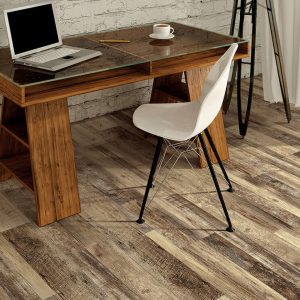All About Resilient Flooring
No matter what type of hard surface you love the most, all homeowners want the styles they purchase to handle the rigors of everyday life in an active home without worry. Just as the name suggests, resilient flooring styles have toughness and the ability to bounce back under pressure. Comfortable underfoot, resilient flooring possesses elasticity to handle foot traffic with ease and return to form, even cushioning dropped items without receiving dents or cracks.
The resilient flooring category has seen huge growth in recent years and shows no signs of slowing down. Affordable and easy to install, resilient styles have also been the beneficiaries of incredible technological innovation that help produce incredibly realistic designs. Today, we take a closer look at this versatile category that’s catching eyes and hearts everywhere.
What exactly is resilient flooring?
By definition, resilient flooring is flooring made with firm materials that also have elasticity and give. Other common denominators among all resilient options are durability, shock absorption and affordability. Resilient flooring can often be sound reducing and made from natural materials as well. The most common resilient options are far and away vinyl and linoleum, followed by cork and rubber.
Vinyl
For residential settings, luxury vinyl tile (LVT) has become one of the hottest products industry-wide for its ability to realistically mimic hardwood and stone in the latest traditional, rustic, exotic and industrial trends. With rigid top layers for enhanced texture and durability, homeowners can capture genuine higher-end looks with LVT planks that would otherwise come at a much higher price. Also much easier and quicker to install and repair, LVT can handle high moisture and high traffic with ease. Vinyl flooring still comes in other traditional formats such as vinyl tile and vinyl sheet, but are more commonly found these days in high traffic commercial settings.

Linoleum
Another common commercial option? The original resilient: Linoleum. Derived from natural materials such as linseed oil, tree resins, and ground limestone, linoleum is highly durable, affordable, quick to install, and a great choice for builders looking to earn environmental certifications. Although linoleum is more limited in design options, new printing capability is producing a greater range of bright colors and should continue to expand.
Cork
Homeowners looking for a bold, environmental-friendly resilient floor can also turn to cork flooring, which is harvested from the bark of the cork oak tree. Since cork trees are not cut down when the bark is harvested, they will grow back every three years. Cork floors provide durability and comfort, and can also be finished in different paints and stains to fit specific color schemes or create unique looks. Cork is not just for wine bottles anymore!
All of these resilient options will provide an outstanding combination of attributes in your home. When you’re ready to explore stylish resilient flooring, get in touch online or speak with one of our flooring specialists at any of our retail locations today!


